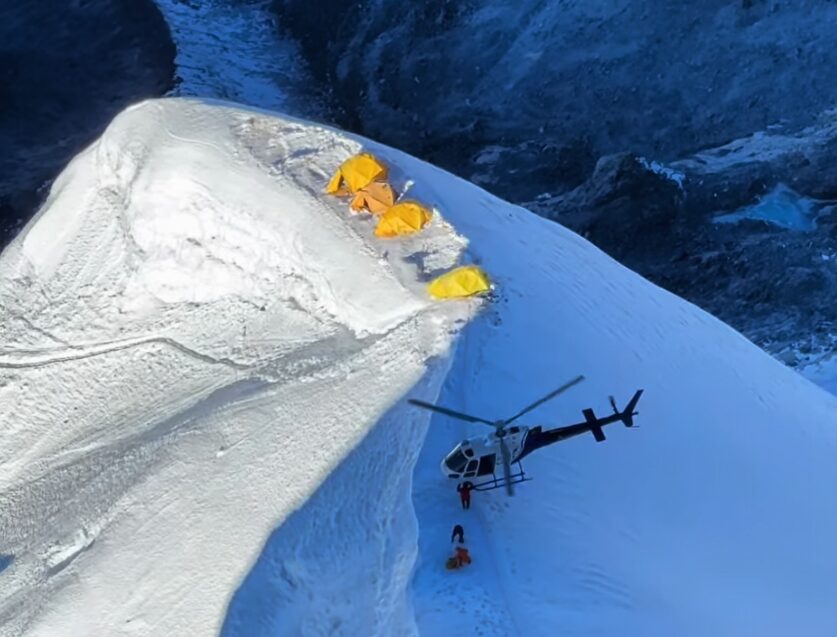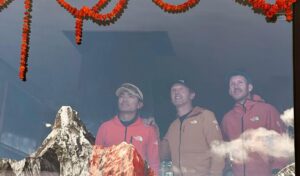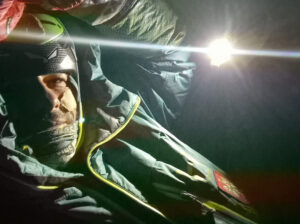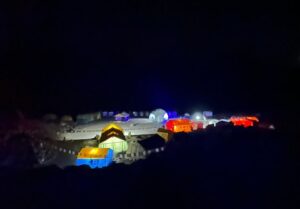“We’ve only been in Base Camp for two nights, and there’s already been four heli rescues from the area of Camp 3,” posted UK guide Tim Mosedale from Ama Dablam last week.
Since then, he has continued to post about the almost daily long-line rescues from Camp 3. Other Ama Dablam guides have confirmed to ExWeb the unusual number of rescues this year above 6,000m.
“Camp 3 is a small and exposed campsite used as a staging point for the summit push,” said Nga Tenji Sherpa of The Summit Force. “Perched on a narrow ridge beneath the mountain’s iconic hanging glacier [the ‘Dablam’], it offers breathtaking views but poses challenges such as limited space, extreme weather, and avalanche risks. Reaching it requires climbing steep mixed rock and ice sections, making it suitable only for experienced mountaineers.”
Why so many?
Why have so many issues occurred at Camp 3 at around 6,300m this year, which require such complex rescues and impressive piloting skills?
An experienced climber who preferred to remain anonymous agreed that the number of airlifts from Camp 3 has increased noticeably this season. Still, operators are not willing to share any information about the causes. In fact, he points to an interesting issue: the availability of such rescues affects behavior.
“If people are insured and [the long-line airlift] is covered by their policy, then it’s an easy decision to make,” he reflected. “If a helicopter at this altitude was not an option, or if it was not covered by insurance, maybe some climbers wouldn’t have [attempted to go] that far, or would have descended to Camp 2 by their own means…or maybe they’d have died.”
The other obvious reason is that many climbers are not as skilled or experienced as they should be. In the specific case of Ama Dablam, others went too high too fast.
The Matterhorn of the Himalaya
Ama Dablam is one of the most popular peaks in Nepal. Often dubbed “the Matterhorn of the Himalaya,” it is one of the most beautiful mountains on Earth. In its latest update on October 16, Nepal’s Department of Tourism granted 158 climbing permits for international climbers on Ama Dablam. This makes it the second most popular peak of the post-monsoon, after Manaslu, with 308 permits.
The difference is that Ama Dablam’s season lasts longer than Manaslu’s. The normal route is fixed from bottom to summit and features three high-altitude camps beginning in September. Teams distribute themselves until the end of November, and some even attempt it in December, when winter climbing permits are cheaper and the weather is cold but typically stable.
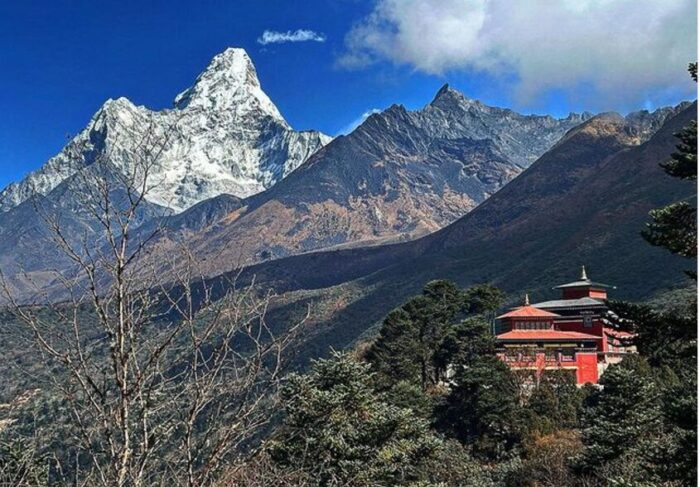
Ama Dablam from Pangboche. Photo: Tim Mosedale
Underestimating Ama Dablam?
Climbing Ama Dablam takes less time than Manaslu does. Its accessible location in the middle of the Khumbu Valley requires a five-day trek with almost the same stages as Everest’s. Only on the last day, climbers leave the main Everest Base Camp trail at Pangboche and head for Ama Dablam Base Camp. The 6,814m peak typically requires only one three-day push.
That makes it great for outfitters, who continuously maintain the camps as clients come and go throughout the season. Although it is not as high as the 8,000’ers, altitude can be a serious issue.
Everyone needs prior acclimatization, either by climbing a trekking peak before settling into Base Camp or by doing a rotation up to Camp 2 and then returning to BC before attempting the summit. Ama Dablam is typically climbed without supplementary oxygen, so proper acclimatization is vital to prevent AMS and frostbite.
Sometimes, however, a good weather window opens right as the climbers arrive in Base Camp. Some may then be tempted to go up immediately. Once in Camp 2, they keep heading up. This is especially true if they can count on a rescue at Camp 3 if things go south.
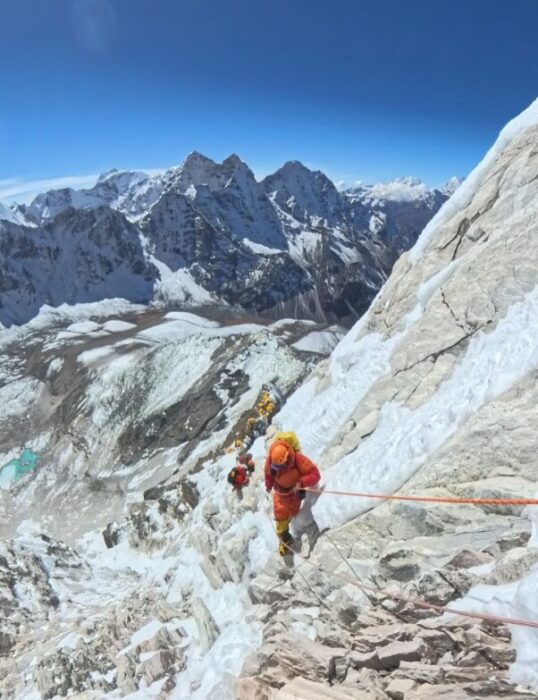
Climbers on their way to Camp 3 on Ama Dablam in great conditions two weeks ago. Photo: 8K Expeditions
Impact on insurance
Prateek Gupta, CEO of the Nepal and India-based insurance company ASC360 (Adventure Sports Cover 360), had only one client airlifted from Ama Dablam’s Camp 3. Still, he is not keen to promote that option among Ama Dablam climbers.
“Climbers there are getting long-lined frequently from Camp 2 and above, which can cost about $18,000 or more,” he explained.
Because of the lack of landing areas above Camp 1, Gupta points out that the most common option for aerial rescue is a long-line operation. Occasionally, a very skilled pilot can hover the helicopter right above Camp 3. However, the increasing number of rescues is discouraging companies from offering high-altitude airlifts.
“The one rescue from C3 [on Ama Dablam] plus medical [expenses] has not only wiped out the entire premiums collected but gave us a big dent otherwise,” he admitted.
He also added that some climbers may start the summit push without proper acclimatization or the technical skills and fitness that the climb requires.

Slightly frostbitten fingers of a climber who was rescued near the summit of Ama Dablam. Photo: Prateek Gupta
Mounting premiums
“Most insurance companies do not provide insurance for trekking and climbing in Nepal, let alone for an almost 7,000m peak,” says Gupta. “Those who do tend to either charge exorbitant amounts — around $1,000 for a 14-day Everest Base Camp trek –or have ridiculous deductibles or co-payments. But this is understandable, as the rescue and medical costs in Nepal are even higher than average medical costs in the U.S.”
He adds that insurance fraud, high billings, and commissions have ruined the insurance ecosystem. “We at ASC360 are trying to survive and provide relatively cost-effective plans and organize cashless services on ground,” says Gupta.
The fraud Gupta refers to involves past under-the-table agreements between guides and helicopter companies that profit from rescues. In 2018, Nepal authorities revealed a scam among some guiding and helicopter companies involving foreign trekkers. They were induced to gain altitude too fast or even had their food spiked in order to prompt aerial rescues. The scandal made headlines around the world and resulted in warnings to international clients.
ExplorersWeb has contacted large international insurance companies for their take on the recent glut of rescues on Ama Dablam.
